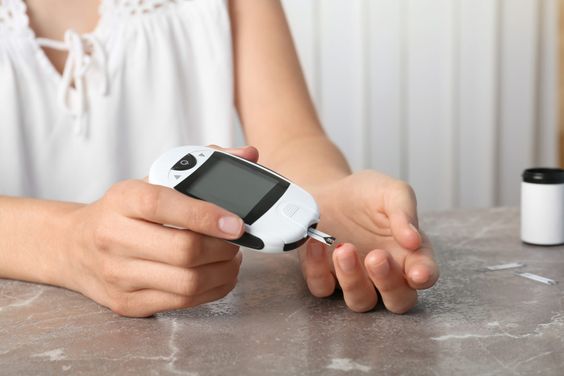Diabetic ketoacidosis, also called DKA, is a severe complication of diabetics. It is a potentially fatal diabetes that occurs when you have much less insulin than your body needs, which can be life-threatening. DKA is most common among people with type 1 diabetes. However, people with type 2 can also develop diabetic ketoacidosis.

DKA develops when your body doesn’t have enough insulin to allow blood sugar into your cells for use as energy. Instead, your liver breaks down fat for fuel, producing acids called ketones. When too many ketones are produced too fast, they can build up to dangerous levels in your body.
In addition, ketoacidosis often causes abdominal pain, nausea, and vomiting, so you can’t keep up your fluid intake.
Learning the Basics
Ketones build up in the blood, seriously altering its everyday chemistry. As a result, you become dehydrated because your kidneys release more water along with sugar. Acidosis also makes you breathe faster, another way to lose water. Diabetic ketoacidosis is associated with hyperglycemia and ketone body formation.
ALSO READ: Is Radish Good for Diabetics? Here’s What Experts Have to Say

Hypoglycemia usually exceeds the renal threshold of glucose absorption and results in significant glucosuria. Consequently, water loss in the urine is increased due to osmotic diuresis induced by glucosuria. This water loss leads to severe dehydration and hypoperfusion, hypotension, lactic acidosis, and also renal impairment.
Symptoms Of Diabetic Ketoacidosis
Diabetic ketoacidosis usually develops slowly. Early symptoms include being very thirsty and urinating a lot more than usual. If untreated, more severe symptoms can appear quickly, such as deep breathing, dry skin and mouth, flushed face, muscle stiffness, or aches.

Sometimes, diabetic ketoacidosis is the first sign of diabetes in people who haven’t yet been diagnosed.
Causes of Diabetic Ketoacidosis
Your body needs insulin to use blood sugar for energy. If you don’t have enough insulin due to untreated type 1 diabetes, your blood sugar goes up a lot because the sugar can’t get into your cells. Therefore, your body burns fat for energy instead.

Then, broken-down fat goes to your liver and is turned into acids called ketones. The ketones build up in your blood and urine. Also, missing insulin shots, a clogged insulin pump, or the wrong insulin dose induces diabetic ketoacidosis.
Other causes may include heart attacks or stroke, alcohol or drug use, physical injuries, and certain medicines, such as some diuretics (water pills) and corticosteroids (used to treat inflammation in the body).
POLL—Should Abortion Be Legal in Most Cases?
Test for Ketones?
Whenever you’re sick or your blood sugar is 240 mg/dL or above, use an over-the-counter ketone test kit to check your urine or a meter to test your blood for ketones every 4 to 6 hours. You should also test for ketones if you have any of the symptoms of diabetic ketoacidosis.

Call your doctor if your ketones are moderate or high. Intensified ketones are a sign of diabetic ketoacidosis, which is a medical emergency and needs to be treated immediately.
How Doctors Know You Have Diabetic Ketoacidosis
Doctors do Blood tests to check your blood sugar, the level of ketones in your blood, and certain electrolytes (minerals, such as sodium and potassium, that help with many important body functions).

Doctors may perform tests such as chest X-rays and urine tests to find problems that might be causing your diabetic ketoacidosis. They also perform an ECG (electrocardiogram), a test that measures your heart’s electrical currents and records them on paper.
WATCH: Wealthy White Louisiana Residents Split From Black Neighborhoods to Form New City
How Doctors Treat Diabetic Ketoacidosis
Diabetic Ketoacidosis is a medical emergency. You’ll need to go to the hospital and may need to stay in the intensive care unit (ICU). Medical experts treat diabetic Ketoacidosis with fluid, electrolytes, and insulin in your vein. They also perform blood tests every few hours to check your sugar, ketones, and electrolyte levels to ensure they return to normal.

In addition, they treat other problems that trigger diabetic ketoacidosis. In summary, the best way to prevent DKA is to commit to managing your diabetes by living a healthy lifestyle and regularly monitoring your blood glucose and ketone levels.
If your levels are not what they should be, act quickly and consult with your doctor about adjusting your dosage or seek emergency care.
You Might Also Like:
6 Health Benefits of Pumpkin Seeds
Florida Rapper Shot Dead at His 26th Birthday Party
“Gigantic” Bird Flu Outbreak Raises Concerns in the U.S.
Elon Musk Accuses Kamala Harris of Lying About Trump’s Stance on Abortion Ban
Tennessee City in Chaos After New Assistant Police Chief Exposed as QAnon Believer


